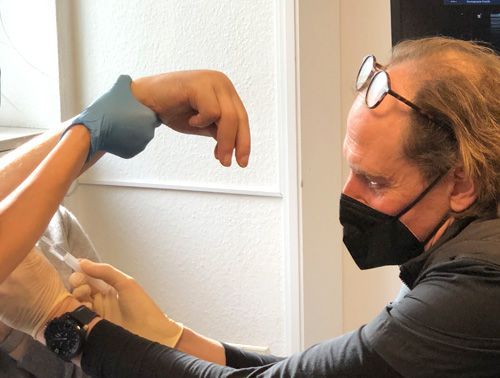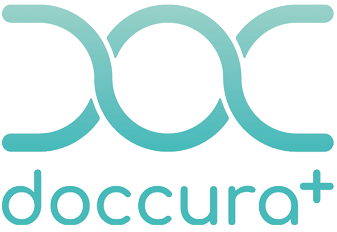What is botulinum toxin?
Botulinum toxin is a substance produced by bacteria. In ancient times, it was known to cause food poisoning through spoiled meat and sausage products. Today, the effects of botulinum toxin are used in medicine. The drug is extracted and processed under strict conditions from the bacterium Clostridium botulinum. The effect of botulinum toxin is so extreme that a few billionths of a gram are enough to relieve cramps. Botulinum toxin is therefore a remedy for spasticity, because it stimulates the overactive muscles to relax.
Botulinum toxin – is it poisonous?
The amount used is important here. As with many natural substances, botulinum toxin is non-toxic to a certain extent. For medical treatment, botulinum toxin is produced in the form of a drug and injected in very small amounts. The active ingredient reaches the target site, i.e. the muscle, directly and only has a targeted effect in that muscle.
How is botulinum toxin produced?
The active ingredient botulinum toxin type A is a protein produced by the bacterium Clostridium botulinum. The active ingredient is isolated, purified and prepared for use as a medication in a complex process. How does botulinum toxin work?
Botulinum toxin type A only works at the junction between nerves and muscles. The transmission of the signal from the nerve cell to the muscle normally takes place at the motor end plate, whereupon the muscle is instructed to contract. The transmission of the signal occurs via chemical messengers. In spasticity, the injection of botulinum toxin controls the deregulation of neural signals that causes the abnormal contraction of the muscle. Overactive muscles can temporarily relax, thereby reducing the symptoms of spasticity.
How does botulinum toxin work?
Improvement can be felt just a few days after the injection. The effect of the treatment reaches its peak within a few weeks and usually lasts three to four months. The therapy must be repeated at regular intervals because the effect of botulinum toxin between the nerves and muscles is only temporary and the active ingredient is broken down by the body. What can botulinum toxin be used for?
Botulinum toxin type A is used to treat various diseases with abnormally high muscle tension, including different movement disorders such as eyelid spasms, torticollis, spasticity or multiple sclerosis.
When should you not use botulinum toxin?
Treatment with botulinum toxin should not be carried out:
- if the patient suffers from a generalized muscle disease if the patient has Lambert-Eaton syndrome if you have a known hypersensitivity to the active substance or any other component of the medication if you have an infection or inflammation
How does the treatment work?
In order to administer the correct dose to the patient, the doctor must determine this using various tests. To do this, the tension and functional state of the muscles must be analyzed. The active ingredient botulinum toxin is injected directly into the over-stimulated muscles. This relieves the tension in the muscles and reduces involuntary movements. The dose must be optimized and readjusted for each treatment.
Are there any side effects?
Botulinum toxin is a prescription drug that relaxes tense muscles. In general, the drug is well tolerated when applied topically. As with all medicines, botulinum toxin can cause side effects, although not all patients experience them. Please check the instructions for use of the prescription drug or ask your doctor about possible side effects. If you experience side effects not listed in the instructions for use, inform your doctor or pharmacist.
Are there any side effects and interactions?
Please ask your doctor about side effects and interactions with certain muscle relaxants and medications.
Video - Patient before and after treatment with botulinum toxinImproved gait stability and reduced risk of falls through botulinum toxin type A in spastic-dystonic supinated-inverted equinus after a stroke.
Source: Dr. med. Martin Schorl, Chief Physician of the Neurological Clinic at the Bad Wurzach Rehabilitation Clinic.
Visit to Dr. Schramm (neurologist) at the NeuroPraxis in Fürth

Photos: Practice Dr. med. Schramm

On Thursday, March 23, 2023, Prof. Dr. med. Siegfried Jedamzik and Ms. Hess had the opportunity to look over Dr. med. Axel Schramm's shoulder at work in the NeuroPraxis in Fürth. Dr. med. Axel Schramm is an experienced neurologist who specializes in the treatment with botulinum toxin (BoNT).During the visit, Dr. med. Axel Schramm showed the two visitors how he treated three patients with BoNT. The first patient had congenital spasticity and was treated with BoNT on his hand and foot. The second patient had cervical dystonia and was treated with BoNT in several places on his neck and throat. The third patient had spasticity in his right arm after a stroke and was treated with BoNT in several places.Due to the different diagnoses, Prof. Dr. med. Siegfried Jedamzik and Ms. Hess were able to see Dr. med. Axel Schramm can understand this very well. A medical assistant supported him by helping the patient get dressed and undressed, drawing up the medication and assisting with the BoNT therapy. Dr. med. Axel Schramm used the support of ultrasound to place the medication precisely at the correct spot in the muscles. As a neurologist, Dr. med. Axel Schramm has special training to recognize muscles, nerves, vessels and organs in the ultrasound image and thus ensure a precise injection.Prof. Dr. med. Siegfried Jedamzik had the opportunity to interview the patients and all patients stated that they felt a significant relief of their symptoms, even pain relief, after just a few days of treatment. These successes are the result of Dr. med. Axel Schramm's outstanding work and his expertise in this field.The visit to Dr. med. Axel Schramm in his practice in Fürth was a valuable experience for Prof. Dr. med. Siegfried Jedamzik and Ms. Hess. They were impressed by the professionalism and expertise of Dr. Axel Schramm and the great results he achieved with his BoNT therapy. They wish him continued success and are grateful for the opportunity to observe his work up close.
Function of the muscle
How is muscle activity controlled? A movement takes place when chemical energy is converted into mechanical energy in the muscle. Motor end plates are the transfer points from muscle to nerve. In order for a controlled and desired movement to take place, the nerve must first release the chemical messenger acetylcholine.
What is a muscle contraction? Muscle contraction is the active contraction and expansion of a muscle. The muscle receives the command to contract via the nerves.
What is the relationship between nerves and muscles? The muscle receives information about whether and how strongly it should contract from the nerves that supply it. Nerve dysfunctions also have a direct effect on muscle activity. The information about tension is transmitted to the muscle by neurotransmitters in the nerve endings. If the neurotransmitters are no longer released, the muscle relaxes permanently.
What is an EMG?
Electromyography (EMG) can be used to measure the natural activity of the muscle, making it possible to identify diseased muscles or the associated nerves. A relaxed muscle normally shows no electrical activity in the EMG, but even the slightest contraction creates electrical voltages that can be measured. In the case of spasticity, a striking pattern can be seen in the electrical activity of the muscle. The EMG is used to visually and acoustically display the overactivity of the muscle, especially when the affected muscle cannot be felt during spasticity.
How does electrical stimulation work? Electrical simulations are used to identify individual muscles for botulinum toxin. A needle electrode is inserted into the muscle, which can also be used for injections. The muscle is contracted by electrical currents and the correct position is checked by electrodes.
How does a computer tomography (CT) work? Computer tomography is used to identify injection muscles that are very difficult to reach, for example deep muscles in the neck. A CT begins by taking images of the affected areas of the body. The tense muscles are then identified and the exact injection site is determined, using the CT images. Once the needle has been positioned precisely, the injection takes place.How does an ultrasound (sonography) work? In addition to electromyography, ultrasound can also be used to identify muscles. The different muscle groups and their location can also be identified in the ultrasound image. This method is mainly used to reach the deeper muscles.
How does diagnosis work using scales? Scales are used as assessment methods to uniformly evaluate and document different clinical pictures. These scales are essential for the success of therapy and for therapy planning. Different scales can be used to record patient feelings on the one hand and objectively measured successes on the other.








